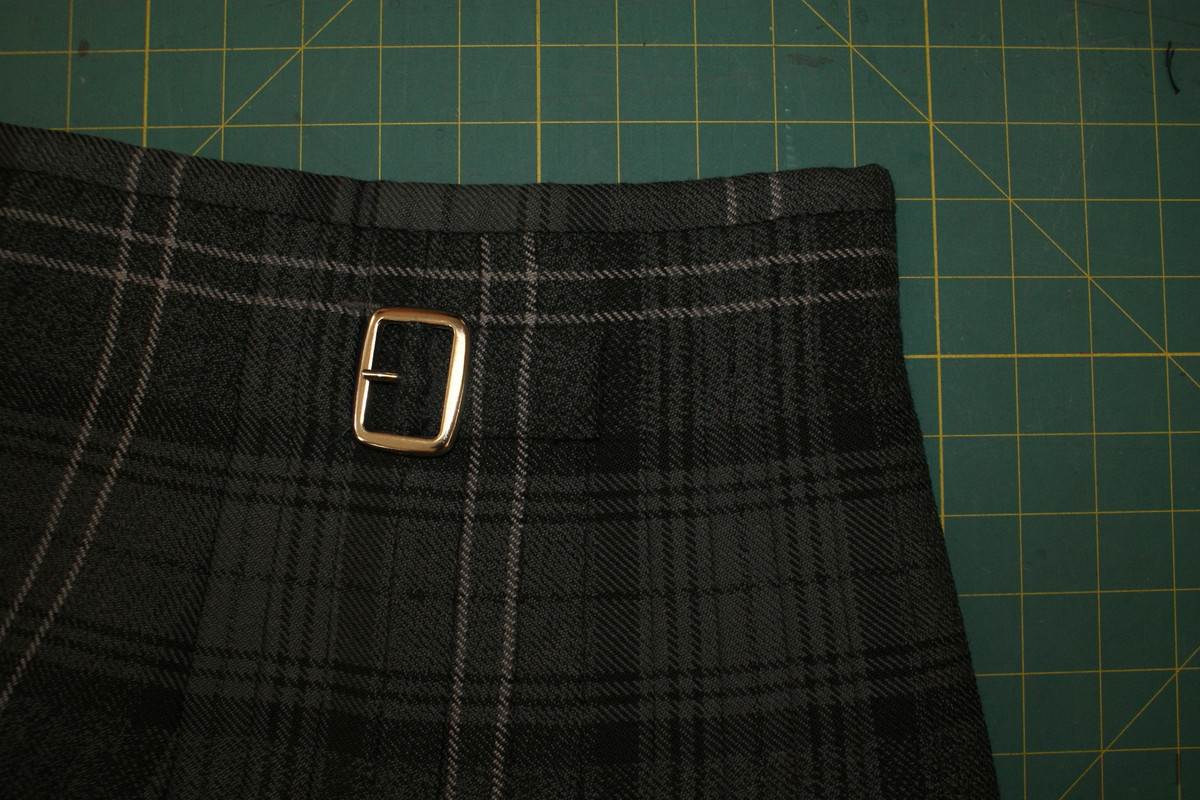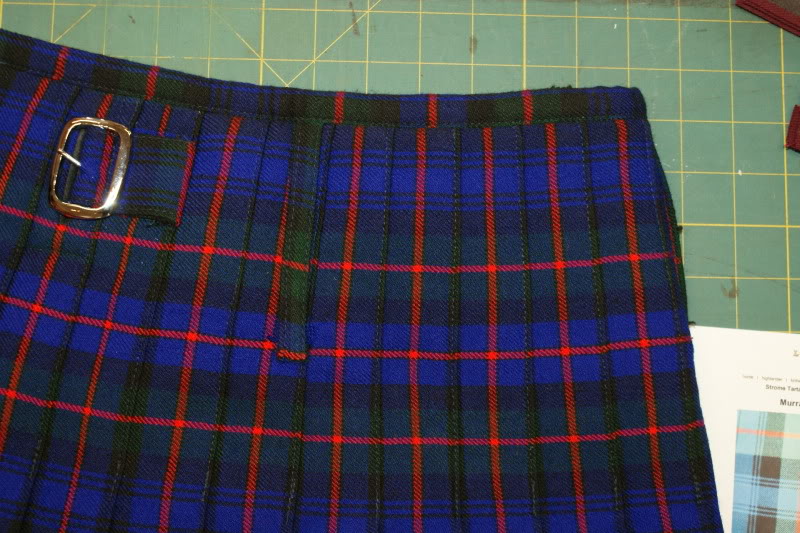|
-
26th April 21, 10:54 AM
#1
Top of Kilt Position –Traditional vs Modern
I’ve read in this forum that the top straps of a traditional kilt should be worn centered at the anatomical waist, i.e., the narrowest point of the torso located just below the ribs. The actual top of the kilt will sit higher because there is a further 2” (or more) of rise, which will hopefully be flared. For a 1” wide leather strap for example, a 2” rise would mean another 1.5” of kilt above the top edge of the strap. All this is well and good, however, I submit that many fabricators of so-called “traditional” kilts these days, judging by their measurement directions, make kilts which are to be worn no higher than the belly button (or just above). Case in point: J. Higgins instructs customers to measure from the ledge of the hip bone to the knee and they will add an extra 2” themselves. The straps would then logically rest right at or slightly above the hip bone, and the top of the kilt would fall near the belly button. (btw J. Higgins is also one of a handful of manufacturers to ask for waist measurements at both the ledge of the hip bone and at the belly button. R.G. Hardie does this too.) USA Kilts doesn’t ask for waist measurements at the ledge of the hip bone, only just above the belly button, which they interpret as the “true waist,” from which one measures down to the knee to get the full kilt length. Again, there is no additional rise above this “true waist.” Same thing with Tartantown: “Length measurement should be taken from natural waist to the middle of the kneecap.” No mention of any further rise. [There are exceptions. Burnett’s & Struth’s measurement form makes you specify the desired rise (from 1-1/2” to 2-1/2”) and two lengths (from hipbone to bottom of kilt and overall finished length from top of kilt to bottom). I guess it’s up to the customer to make sure the numbers add up… They actually also don’t specify which waist measurement they want; so in this case, you could choose to measure it at the anatomical waist, belly button, or hip bone as desired, but whatever you choose, that’s where your straps are going be.] So I guess my point with all of this is that we have to be a tad careful when we say that traditional kilts are worn with straps at the anatomical waist with a rise higher than that, because what passes as a “modern traditional” kilt these days does not. In fact, they’re often a good 2 inches lower. At any rate, I do very much prefer the modern lower-wearing traditional kilt…I happen to think it looks better proportion-wise on the body, is less restrictive, and cooler in the summer.
-
The Following User Says 'Aye' to Triathan For This Useful Post:
-
26th April 21, 12:59 PM
#2
You are correct.
At the time the "Traditional kilt" (as described in TAoK) was developed, all men's trousers were worn higher than trousers are worn today.
This style of waist height is called "The Anatomical Waist" and is based on the bodies bones instead of soft tissue. The human spine naturally bends at a point just under the rib cage.
The also happens to be the smallest part of a guys body. Even for those guys with a bit of a belly.


So of course the kilts developed at the same time would have a waistline in keeping with the current fashion.
However, since the introduction of blue jeans the height of the waist of both men's trousers and ladies pants have changed.
Many guys today have never worn trousers, or anything else for that matter, at their anatomical waist.
Today the waist height of trousers is just above or just below the top of the hip bones.
Perhaps this can illustrate


The upper strap in these photos is at the anatomical waist and is commonly called "Full Waist Height".
The Middle strap is just on top of the Illiac Crest of the hip bones and is commonly called "Mid Waist Height".
And the Lower strap is down where blue jeans are worn, over the hip bones, and is commonly called "Low Waist Height".
These photos show the locations of the kilts upper straps. They do not show any Rise.
On a "Traditional" kilt the Rise is flared for 2 inches above the center of the top strap. This would put the top of the kilt about 3-4 finger widths below the bottom of the breast bone when the top straps are cinched into the anatomical waist.
Here is the flared rise of a Traditional kilt designed to fit over the bottom of the ribs. The smallest part of the kilt is at the level of the top straps and is what chinches into the anatomical waist making it very comfortable to wear.

Many kilts made today have very little or no tapered rise.
This has cause untold frustration for today's kilt wearers as the smallest part of the kilt is the top band. So a kilt made like this does not cinch into the body with the straps and always wants to drop down. This is one of the reasons that you see so many kilts with the bottom below the knee. The kilt does not fit and slides down.

As a side note - the lower right strap was put on kilts when they were worn higher to help present a smooth line to the front apron. Today with kilts worn lower the second right strap must be worn loose, or left off altogether, so as to prevent distortion of the front apron.
And another - The navel or belly button is located on soft tissue and is in different positions relative to the bodies bones. The more of a belly a guy has, the lower his belly button is. Using the belly button as a reference for kilt measuring is one of the most unreliable methods. The most reliable and accurate method would be to measure the height of the hips. The waist would then be measured UP from the hips and the bottom DOWN from the hips.
And a third - As you can see in the photo above of the three straps, the lower a guy wears his kilt, the more the front will be lower than the back. This is what I call "Slope" and if Slope is not taken into account when the kilt is made, the front apron will often have an unsightly pucker to it. The sporran must also be worn lower on lower waisted kilt leading to what we in the business refer to as the "crotch protector" position. If the kilt is worn higher, the sporran sits on the front of the belly and does not hit in sensitive places.
Last edited by Steve Ashton; 26th April 21 at 01:16 PM.
-
The Following 7 Users say 'Aye' to Steve Ashton For This Useful Post:
-
28th April 21, 06:43 AM
#3
Those vintage photos of men's trousers tell the tale, don't they?
I think the modern men's suits with the super-low-cut trousers look ridiculous.
In any case, there's the traditional civilian kilt height, and the traditional military kilt height which was even higher.
There aren't many photos of vintage soldiers not wearing jackets, here's the few I've found.

Proud Mountaineer from the Highlands of West Virginia; son of the Revolution and Civil War; first Europeans on the Guyandotte
-
The Following 3 Users say 'Aye' to OC Richard For This Useful Post:
-
28th April 21, 02:54 PM
#4
Richard, I'm surprised you don't have this one

-
The Following 2 Users say 'Aye' to McMurdo For This Useful Post:
-
29th April 21, 11:06 PM
#5
I, for one, must chime in and state how I hate modern trousers! Today's leg prisons of all types and sizes are hip-huggers on men! Even when wearing a fully tightened belt they keep wanting to creep down. Dress pants, jeans, even my Army surplus ACU trousers all are too low at the belt loops to be comfortable and kept up all day. Hike 'em up till you're cleft in twain, and it still isn't high enough.
If I must be pantalooned, I prefer the vintage types, like my M1951 wools with braces. At the natural waist and with braces makes a pantalooned day more tolerable.
My main kilt is my high-rise Great War pattern, and it pretty well replicates these gents here. It is comfortable all day, but can be a little tight in the ribs when sitting in the car for long periods.
-
The Following User Says 'Aye' to KnittedReenactor For This Useful Post:
-
30th April 21, 01:13 PM
#6
Genuinely can't imagine wearing a kilt that doesn't sit at the natural waist. This is presumably why the dreaded gap between kilt and waistcoat is so commonly seen these days 
EEM
"Humanity is an aspiration, not a fact of everyday life."
-
The Following 3 Users say 'Aye' to Micrographia For This Useful Post:
-
 Originally Posted by McMurdo

They almost look like aprons rather than kilts.
-
-
What a wonderful thread. High cuts and suspenders, the only way to fly in comfort. I think I'm one of the few who wears a kilt apron in foul weather. They are cut high as well. Where the pattern came from I'm not sure but most likely military.
Piping Is Life!....The rest doesn't matter.
-
The Following User Says 'Aye' to Grump For This Useful Post:
-
Yes Grump, it is of military origin. During the Boer Wars, Highlanders wore a front only apron, and during WWI and WWII, they wore a full wrap, pleated apron. They were not used again after 1940. If someone has contradictory information, I'd love to hear it.
What Price Glory and Soldier of Fortune make reproductions, and I think someone here made a few as well.
-
-
11th May 21, 12:05 PM
#10
 Originally Posted by KnittedReenactor

... During the Boer Wars, Highlanders wore a front only apron, and during WWI and WWII, they wore a full wrap, pleated apron.
Can you explain what is meant by a front only apron, in a kilting context? It sounds somewhat revealing at the rear, but obviously I'm misunderstanding.
-
 Posting Permissions
Posting Permissions
- You may not post new threads
- You may not post replies
- You may not post attachments
- You may not edit your posts
-
Forum Rules
|
|




























Bookmarks